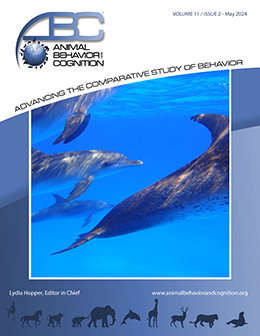Vol 11, Issue 2, May 2024
Wild Baboons Groom Objects with Fur: Implications for Infant Corpse Carrying in Primates?
Citation
Reiderman, H., Dezeure, J., & Carter, A. J. (2024). Wild baboons groom objects with fur: implications for infant corpse carrying in primates? Animal Behavior and Cognition, 11(2), 208-224. https://doi.org/10.26451/abc.11.02.05.2024
Abstract
Nonhuman primates demonstrate great behavioral diversity in their responses to death, yet the most prevalent of these—infant corpse carrying—remains poorly understood. While mothers are the most frequent carriers, corpse carrying can be performed by non-mothers, and heterospecifics’ corpses are also carried. We propose a new hypothesis to explain, in part, non-maternal corpse carrying, the ‘mammalian cues hypothesis,’ and experimentally test it in a population of wild baboons. The mammalian-cues hypothesis argues that evolutionary pressures on maternal responsiveness have created a generalized attraction towards mammalian-typical traits in mammals of both sexes. This attraction may drive interest in inanimate objects (including corpses) that display mammalian cues. To test this, we presented objects that varied in mammalian traits to wild chacma baboons (Papio ursinus) and recorded their behavioral responses. Contrary to our hypothesis, baboons handled all objects (i.e., with or without mammalian traits) for similar lengths of time. However, in partial support of our hypothesis, baboons groomed the objects with fur—even those without any other mammalian traits—and explored them in a less destructive manner. We caution that infant corpse grooming by non-mothers in primates may be indicative of the visual and tactile stimuli the corpse presents rather than an interest in death or a reflection of social bonds.
Keywords
Cognitive bias, Core knowledge systems, Corpse-carrying, Primate, Thanatology
